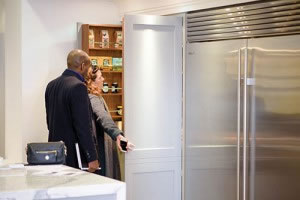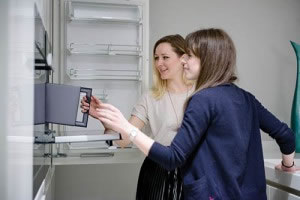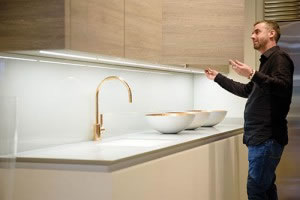What they really, really want…
What are people looking for when buying a luxury kitchen? David Harris asked customers at Halcyon Interiors and Roundhouse in London’s Wigmore Street
What do big spenders want from their kitchens? And what do they want from the kitchen retailers that provide them? These questions are important wherever top-level kitchen showrooms ply their trade.
Robert Stewart, who this year installed a £79,000 kitchen in his Chiswick home, still remembers walking up and down London’s Wigmore Street as he and his wife considered which retailer might best meet their needs.
What were they looking for? Well, they moved into their Chiswick house in 2001 and had made an already large kitchen larger by extending it into their conservatory. Stewart had “given up work” and the couple were considering whether to move house but decided to stay put and make the most of what they already had.
Stewart says: “We were in a position to move to a much bigger house but stamp duty is so much that, if you rather like your existing home, you may as well spend the money on making it nicer, which is what we did.”
 The couple were clear about what type of kitchen they wanted. Stewart explains: “Part of our motivation was to get as much light as possible into the room, so the windows were very important. We were also clear that we didn’t want to go with a traditional kitchen. What we didn’t want was to make a Chiswick kitchen look as if it were in Bath.”
The couple were clear about what type of kitchen they wanted. Stewart explains: “Part of our motivation was to get as much light as possible into the room, so the windows were very important. We were also clear that we didn’t want to go with a traditional kitchen. What we didn’t want was to make a Chiswick kitchen look as if it were in Bath.”
Standout showroom
He continues: “When we were walking down Wigmore Street, the showroom that really stood out for us was the Alno showroom [Halcyon Interiors]. It was distinctly more striking than anywhere else. When we went in and began talking to Graham Robinson, the showroom manager, it became apparent that this was the right place for us. He is, in my view, quite the most fabulous designer.”
Once he had seen the space the Stewarts had available in their kitchen, Robinson suggested they install a particularly large island.
Stewart explains: “To give you an idea of its size, an architect came into the house – he was not connected to the kitchen project – and when he saw the island, he said: ‘That’s not an island, that’s a semi-peninsula!’”
Oversized kitchen island
Most importantly, the Stewarts are clearly very happy with the decision to put in the big island. Stewart says: “Graham was positive about it so we were persuaded by him, even if we were a little anxious about whether it was the right decision. But as soon as we saw it put in, we were absolutely clear that it was the right decision.”
 The Stewarts were very keen to ensure that the kitchen was never used as a laundry. To this end, while they were creating their kitchen, they also extended their cellar and turned it into a laundry room to house the washing machine and tumble dryer. The kitchen now only contains cooking appliances, such as two Sub-Zero fridges (one for food and another for wine) and two Miele ovens.
The Stewarts were very keen to ensure that the kitchen was never used as a laundry. To this end, while they were creating their kitchen, they also extended their cellar and turned it into a laundry room to house the washing machine and tumble dryer. The kitchen now only contains cooking appliances, such as two Sub-Zero fridges (one for food and another for wine) and two Miele ovens.
Another customer of the Alno store, Pat Page, is in a wheelchair and wanted not just a luxury kitchen but one specifically tailored to her needs. The requirements included good access, of course, but also less obvious features such as ceramic doors that would not mark when she bumped into them with her wheelchair.
Page says: “You get to know what you need and with the last two kitchens I had, I realised you can’t help knocking into cupboard doors and damaging the surface. I needed something that was really robust.
“I saw a friend’s kitchen, which I liked, and she pointed out that the doors were ceramic and wouldn’t mark. She recommended Graham and Halcyon and so we thought we would ask them what they could do.”
It wasn’t a quick sale, however. Page says that, after seeing her friend’s kitchen, she took 18 months to decide what she was going to do. She did a lot of research on other exterior finishes before finally choosing Alno and buying from Robinson. Page knew that she wanted handleless cupboards, again because her chair tends to knock against handles, and that she wanted the kitchen to have a contemporary look.
Good advice seals the deal
 Page also says that Robinson’s advice and help were crucial in sealing the sale. For example, he persuaded her and her husband to go for an induction hob, rather than the gas model they had originally wanted. They bought a Miele hob, which had the important benefit of having all the controls at the front, rather than on the sides, giving Page easier access from her chair.
Page also says that Robinson’s advice and help were crucial in sealing the sale. For example, he persuaded her and her husband to go for an induction hob, rather than the gas model they had originally wanted. They bought a Miele hob, which had the important benefit of having all the controls at the front, rather than on the sides, giving Page easier access from her chair.
Halcyon also arranged for a table to be made for the kitchen with enough space below it to enable Page’s chair to fit underneath perfectly. None of this came particularly cheaply – Page and her husband paid £39,000 for the kitchen.
Page had to move out of her house while the kitchen was installed and other alterations were done. However, she has been using her new kitchen for a few months now and is clearly happy with the results. “It’s the old story,” she says. “You get what you pay for.”
Robinson is no doubt pleased that Stewart and Page are delighted with their Halcyon kitchens. However, he believes most good retailers in any sector of the market are likely to share his philosophy for kitchen design and he tries to remain adaptable.
“Everyone is different so it’s not the same every time,” Robinson explains. “The key is in entering into a relationship with the customer and you have to judge quite quickly what they want from you. Some want you to go into loads of detail about every corner of the kitchen, others just want to know the colour of the wall.
“It’s also very hard to know when someone has decided to buy from you. I’ve had occasions when someone has come back five or six times asking questions and, when they have finally placed an order, they have told me: ‘We liked the first worktop you showed us and that’s when we decided to buy from you.’”
 This process of a customer deciding to buy from a retailer early on in the process but taking some time to fully commit seems quite common. Robinson recalls another recent sale that took a year to come to fruition. “A man came in and, to be honest, to look at him, you wouldn’t think he had much money,” he recalls. “It took a year but this customer later told me that he had decided on day one that he was going to get his kitchen from us. He spent £75,000. He said that it was the site visit that did it because I understood what it was he wanted.”
This process of a customer deciding to buy from a retailer early on in the process but taking some time to fully commit seems quite common. Robinson recalls another recent sale that took a year to come to fruition. “A man came in and, to be honest, to look at him, you wouldn’t think he had much money,” he recalls. “It took a year but this customer later told me that he had decided on day one that he was going to get his kitchen from us. He spent £75,000. He said that it was the site visit that did it because I understood what it was he wanted.”
What some customers want, he adds, is not to talk much about kitchens at all. One American customer, who bought a kitchen from Halcyon, spent much of her time talking to Robinson about the relative merits of various London restaurants. “She hardly mentioned the kitchen other than in general terms. She just wanted us to do it for her,” he remembers.
First impressions count
But whatever a customer wants from their retailer, service always seems vital and first impressions count. Min Patel looked up and down Wigmore Street when he was extending his house in Rickmansworth, tripling the size of his kitchen to 10 metres by five metres.
Patel was immediately impressed by Roundhouse. “I hadn’t actually heard of them but I popped in and they were very approachable and sat down with me and started talking seriously with no immediate commitment,” he says. “I liked the idea that they made bespoke drawers and, because a project like mine was so complex, I wanted someone who understood the whole process. We wanted something contemporary but subtle and I said to them that I didn’t mind spending upwards of £30,000 or £40,000 but that £50,000 was probably the limit. They were very helpful in finding ways of saving money – as well as spending it. For example, we went for Siemens rather than Gaggenau equipment. It was important that the Roundhouse staff obviously knew what they were talking about, which meant that I trusted them completely.”
Even so, Patel did shop around, getting different quotes from 10 different retailers before settling on Roundhouse as his supplier of choice.
Graham was positive about the large island so we were persuaded, even if we were a little anxious about whether it was the right decision. But as soon as we saw it put in, we were absolutely clear it was the right decision
He explains: “With some shops, it became evident fairly quickly that they wanted to shift something they had in store or were tied to one product or supplier, which was restrictive.”
It was also important to Patel that Roundhouse worked closely – and well – with his architect and builder. “I liked their cooperative approach,” he says.
Craig Matson, managing director of Roundhouse, adds that working with architects and interior designers is the norm for his company. “A lot of our customers take guidance from their architect. However, most of them are intelligent people and they know the difference between a specialist and those who are more general designers,” he says.
It also helps that Matson himself is an architect – one who happens to have specialised in kitchens – so customers can be assured of his expertise on every front.
Forget the hard sell
What do customers want when they come into the shop? “Quite often they want to be left alone. That’s fine. At this end of the market, there is no point hard selling to anyone. You need to engage with them and find out what they are looking for,” Matson explains. “But, in the nicest possible way, you need to establish a budget. Even when they won’t tell you, you need to make a judgement. Nobody should leave the showroom without some idea of their budget and timescale.”
 Of course, there are challenges. In Matson’s terms, one of the biggest is often a matter of “aesthetics versus practicality”, which sometimes comes down to space. In London, for instance, where even multi-million-pound apartments can have fairly small kitchens, it is no use promising a customer an island that seats 20 in a kitchen that cannot accommodate it.
Of course, there are challenges. In Matson’s terms, one of the biggest is often a matter of “aesthetics versus practicality”, which sometimes comes down to space. In London, for instance, where even multi-million-pound apartments can have fairly small kitchens, it is no use promising a customer an island that seats 20 in a kitchen that cannot accommodate it.
Matson says: “That is a very obvious example but you do need to explain to customers what they cannot have, as well as what they can.”
In common with Robinson, Matson believes that success comes down to forging an individual relationship with customers. Matson says: “Customers use a lot of routes to get to us – websites, magazines, just dropping in to the shop – but what matters most is that there is a bond and understanding between us. We have to be their trusted adviser and advise them in a flexible way.”